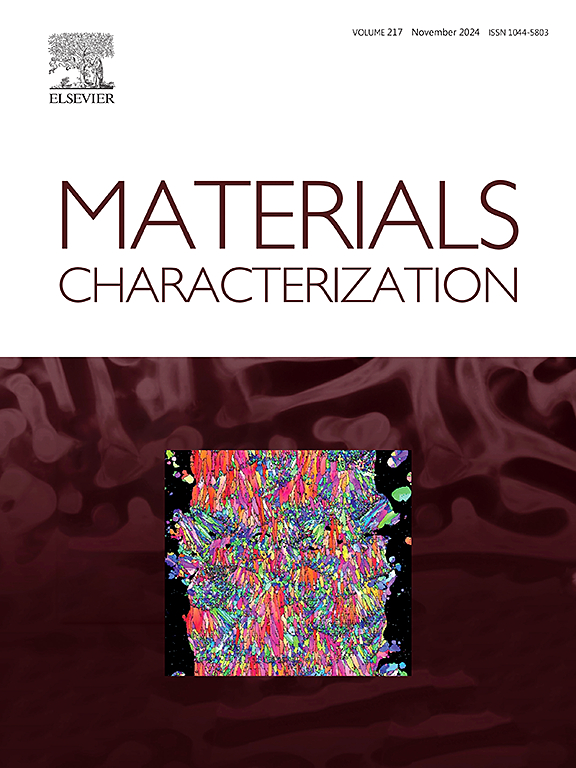In situ observation of eutectic and primary TiB formation and their thermodynamic and kinetic mechanisms during the solidification of titanium alloys
IF 5.5
2区 材料科学
Q1 MATERIALS SCIENCE, CHARACTERIZATION & TESTING
引用次数: 0
Abstract
To investigate the thermodynamic and dynamic formation mechanism of eutectic and primary TiB particle morphologies, a Ti-4Al-6Cr-5Mo-8Nb alloy with varying boron contents was prepared, and in-situ observations were conducted during solidification. The phase morphology, distribution, transformation during solidification, and thermodynamic calculations were systematically studied, and the underlying mechanisms were revealed. The results show that when the boron content is 1.2 wt%, both eutectic and primary TiB phases are present, whereas at a boron content of 0.4 wt%, only the eutectic TiB phase is observed. The eutectic TiB appears as fine, short rods predominantly located at β grain boundaries, while primary TiB forms large, elongated needles distributed across β grains. The average lengths of the eutectic TiB and primary TiB are 6.16 μm and 37.87 μm, respectively, with both exhibiting a similar width of approximately 2.65 μm. Compared to 0.4B alloy, the β grain size in 1.2B alloy decreased by 65 %. Thermodynamic calculations determined the effective phase transformation driving force for the formation of primary TiB to be 119.6 J/mol, with a theoretical size of 34.55 μm. The theoretical size of eutectic TiB at a born content of 0.4 wt% was calculated to be 5.26 μm, based on a maximum growth rate of 3.75 × 10−11 m/s during the eutectic reaction. A paired t-test confirmed that the error between the calculated and experimental values was within acceptable limits. The conclusion of this article can provide a theoretical and experimental foundation for predicting the sizes of TiB in boron-modified titanium alloys.
钛合金凝固过程中共晶和初晶TiB形成的原位观察及其热力学和动力学机制
为了研究共晶和初生TiB颗粒形貌的热力学和动力学形成机制,制备了不同硼含量的Ti-4Al-6Cr-5Mo-8Nb合金,并对凝固过程进行了现场观察。系统地研究了凝固过程中相的形态、分布、转变和热力学计算,揭示了其机理。结果表明,当硼含量为1.2 wt%时,共晶TiB相和初生TiB相同时存在,而当硼含量为0.4 wt%时,只存在共晶TiB相。共晶TiB表现为细而短的棒状,主要位于β晶界,而初生TiB则形成大而细长的针状,分布在β晶界上。共晶TiB和原生TiB的平均长度分别为6.16 μm和37.87 μm,宽度均为2.65 μm。与0.4B合金相比,1.2B合金的β晶粒尺寸减小了65%。热力学计算表明,初生TiB形成的有效相变驱动力为119.6 J/mol,理论尺寸为34.55 μm。根据共晶反应过程中最大生长速率为3.75 × 10−11 m/s,计算出在生长量为0.4 wt%时共晶TiB的理论尺寸为5.26 μm。配对t检验证实,计算值和实验值之间的误差在可接受的范围内。本文的结论可为硼改性钛合金中TiB的尺寸预测提供理论和实验依据。
本文章由计算机程序翻译,如有差异,请以英文原文为准。
求助全文
约1分钟内获得全文
求助全文
来源期刊

Materials Characterization
工程技术-材料科学:表征与测试
CiteScore
7.60
自引率
8.50%
发文量
746
审稿时长
36 days
期刊介绍:
Materials Characterization features original articles and state-of-the-art reviews on theoretical and practical aspects of the structure and behaviour of materials.
The Journal focuses on all characterization techniques, including all forms of microscopy (light, electron, acoustic, etc.,) and analysis (especially microanalysis and surface analytical techniques). Developments in both this wide range of techniques and their application to the quantification of the microstructure of materials are essential facets of the Journal.
The Journal provides the Materials Scientist/Engineer with up-to-date information on many types of materials with an underlying theme of explaining the behavior of materials using novel approaches. Materials covered by the journal include:
Metals & Alloys
Ceramics
Nanomaterials
Biomedical materials
Optical materials
Composites
Natural Materials.
 求助内容:
求助内容: 应助结果提醒方式:
应助结果提醒方式:


